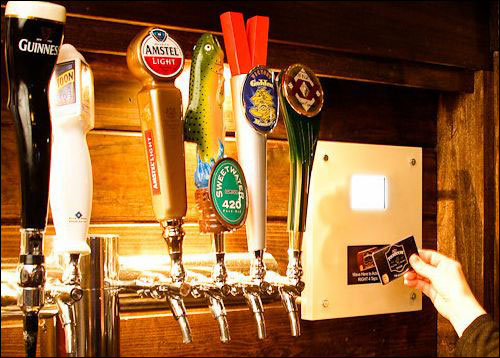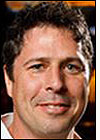While customers at Cheeky, a Latino restaurant in Georgia, await a dining table, beer enthusiasts among them can help themselves to the draft of their choice, in the amount that they choose. If they would like to sample a few ounces of a specific brew, they need only use an RFID-enabled card to serve their own drinks, and then pay for the exact amount consumed.
The beer-management system, known as DraftMagik, manages what the restaurant calls the “Wall of Beer,” and enables patrons to pour their own glass of beer, while shutting off for customers who have reached a preset limit. The solution’s components include RFID-enabled customer cards, RFID readers embedded in a wall-mounted fixture that includes beer taps, framed Apple iPods that display information regarding each beer, and software to manage the delivery and measurement of draft beer that restaurant patrons consume. DraftServ Technologies, a provider of draft-beer management and control solutions, designed the DraftMagik system.

During a 2007 trip to the Spanish city of Madrid, Cheeky’s owner, Jose Hevia, visited a restaurant with pour-your-own-beer tables. The system that Hevia observed did not utilize radio frequency identification, nor was it designed and installed by DraftServ. But later, upon returning to the United States, he asked DraftServ to develop a similar solution for his own restaurant, located in Suwannee, Ga.
Like the system in Madrid, the solution developed by DraftServ also did not employ RFID. Instead, patrons provide their credit-card account and proof of age to a restaurant employee, after which the worker programs the DraftServ software to allow a maximum amount of ounces to be poured at that table (based on the number of patrons seated there). The customers in that party can then pour their own glasses of beer from a single tap installed at their assigned table, while DraftServ flow meters on the keg taps measure the amount being dispensed. When finished, a patron presses a button on an iPod mounted at the table, which automatically shuts down valves connected to the flow meter on that table’s tap. The software then totals the amount due, based on the volume of beer consumed, and the staff provides the patron with his or her bill.
DraftServ set up the single-tap pour-your-own-beer system at six tables in Hevia’s Suwanee restaurant in 2007, each serving only one type of beer: Dos Equis lager. Thanks to the system, says Jerry Bucher, DraftServ’s cofounder and VP of marketing and sales, the restaurant more than doubled its beer revenue for those tables. Hevia also hoped to install the solution at his new restaurant, located 12 miles away, in the city of Cumming. However, the patrons at that location are interested in sampling beers from a wide variety of microbreweries, and the tables could support only a limited number of table taps, due to the smaller table size, as well as the need to run lines from kegs to the taps. As a result, Bucher began looking into developing RFID solutions that would allow multiple taps to be installed at a public location that all patrons of a bar or restaurant, could access via an RFID-enabled card. To that end, he met with Impinj, a provider of ultrahigh-frequency (UHF) EPC Gen 2 RFID hardware, and purchased a development kit to determine if the system would work.
The result, Hevia says, was Cheeky’s Wall of Beer, with eight taps, each serving a different type of beer, and two iPods displaying the various offerings available on tap. Patrons can walk up to the wall and help themselves to the draft of their choice, he explains. An Impinj Speedway Revolution reader is mounted inside the wall fixture, with an Impinj Mini-Guardrail antenna installed behind an iPod mounted on the fixture. Upon arriving, a customer can present his or her credit card to a staff member, who then makes an imprint of it and hands the patron an RFID-enabled card that Cheeky’s dubbed a J.C. Pourhouse card.
The card comes with a UHF Gen 2 RFID tag containing a unique ID number linked with the customer’s information, such as a credit card number, in the DraftMagik software. Each patron is permitted to dispense up to 32 ounces of beer, so if a party of two adults requests an RFID card, the system is programmed to permit up to 64 ounces for that specific card. Employees on the bar floor, known as pour tenders, provide the cards, explain how they work, and are responsible for watching the wall, and for ensuring that no minors attempt to pour a glass of beer, and that no single member of a given party consumes too much alcohol.
When approaching the Wall of Beer, a patron taps his or her card near the iPod. The reader antenna behind that iPod captures the card’s ID and forwards it to the DraftMagik software, on a server hosted by DraftServ, via a cabled connection. The software links the ID with the amount of beer permitted for that card, and the user can then proceed to pour a drink. The tap’s DraftServ flow meter measures the amount of beer being poured, and sends that data to the software in real time, thereby updating the card’s balance. If a patron has reached his or her card’s limit, the tap immediately shuts off, and that individual is unable to pour more. At that time, the customer can find a restaurant worker and request that his or her card be replenished to allow more beer to be poured, as long as the employee determines that the individual is not excessively inebriated.
Once finished, the patron presents his or her RFID card to the restaurant staff, and a bill is then issued, or the balance owed is added to that person’s dinner check. The system has been in place since the Cumming restaurant opened in March 2010, Hevia says, and is especially popular among those awaiting a table at dinnertime. “I know people tell their friends about it,” he states, adding that he has witnessed customers explaining the system to their companions upon arriving. The ability to pour their own beer seems to please patrons, he says, noting, “I’ve seen them argue over who gets to pour the beer.”
The system benefits restaurants and their customers in several ways, Bucher reports. First, a restaurant has greater control over the amount of beer being poured and billed. There is no chance of wasted beer from over-pours (such as could occur when a pour leads to foam that flows out of the glass), since users pay for the exact amount dispensed from the tap. What’s more, he says, the sale of beer increases with the pour-your-own system, and workers are freed up to attend to other tasks. For patrons, the system allows them to select exactly how much they will drink—a customer wishing to sample an unfamiliar beer, for instance, can pour just a few ounces, while also reading about that particular ale or lager on the iPod. If the patron drinks slowly, he or she can pour a smaller glass and then refill it, in order to avoid having the beer become warm or flat.
The Impinj readers proved to be the best choice for the system, Bucher says, because they are designed for an industrial setting, and are thus robust and unlikely to break due to heavy use. This is important in the bar business, he notes, since a restaurant would lose business as soon as the system went down if a reader were to fail.
According to Bucher, DraftServ’s RFID-enabled pour-your-own-beer tables and walls are being used or planned for installation at restaurants located in Manchester, United Kingdom; in Singapore; and in Las Vegas, Minneapolis and other U.S. cities.



